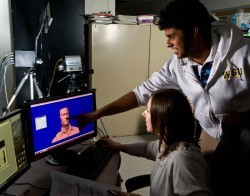Marc Abrahams's Blog, page 609
January 5, 2012
"to make the Arabic subjects angry" at Wright State
 If you are a researcher in an American university, and you have decided—for research purposes—to do something you describe as "make the Arabic subjects angry", then how do you do it without contravening your university's ethics code? A press release suggests that researchers at Wright State University have faced this question.
If you are a researcher in an American university, and you have decided—for research purposes—to do something you describe as "make the Arabic subjects angry", then how do you do it without contravening your university's ethics code? A press release suggests that researchers at Wright State University have faced this question.
Background:
"You're a freshly minted high school grad strolling down the street of your small Ohio hometown, giving a nod to the village barber, your former coach and the girl next door. The next thing you know, you're a rifle-toting soldier. And the streets you're walking are those of Afghanistan, where you encounter people who speak Pashtu and Dari, pray five times a day, and where buzkashi is the national sport."
The scenario described above is from the press-release (dated January 10, 2011). The document summarises attempts to create culture-specific virtual humans for the US Army. Assistant professor Julie Skipper and fellow researcher professor Jennie Gallimore (director of Wright State University's Center of Excellence in Human-Centered Innovation) have been awarded a grant to give soldiers realistic cultural training by creating virtual humans.
In order to add realism to the virtual 3-D characters, the team intend to :
"…bring in people of Arabic background as well as subject-matter experts. Expressions reacting to scenarios will be recorded in a laboratory setting."
The idea being to record true emotional responses, which can subsequently be incorporated into the avatars.
"For example, efforts will be made to make the Arabic subjects angry so they drop their guard. They will be monitored to see when they make and break eye contact, and how much personal space they give people with whom they interact. And the meaning of their gestures will be scrutinized since gestures can mean totally different and sometimes opposite things in different cultures."
But how does 'making the Arabic subjects angry' (in a laboratory setting) square with Wright State's 'Ethics Statement'? It states:
"Respect : Members of the university community will show concern for the individuality of others and their ideas."
In order to find out, Improbable has sequentially e-mailed both professors – and Wright State's Assistant Director of Public Relations – but as yet has received no reply or acknowledgement from anyone at WSU.
Note: For those unfamiliar with Buzkashi it's described in detail here.

January 4, 2012
When the gorilla met the fingernails on a chalkboard
This study tells what happened when two Ig Nobel Prize-winning experiments were combined:
"Inattentional blindness for a noxious multimodal stimulus," Joseph F. Wayand, Daniel T. Levin and D. Alexander Varakin, American Journal of Psychology, vol. 118, no. 3, Fall 2005, pp. 339-52. The authors, at DePauw University and at Vanderbilt University, explain:
"Previous research has shown that people can miss salient stimuli outside the focus of their attention. This phenomenon, called inattentional blindness, typically is observed when people are given a task requiring them to focus their attention on one aspect of a complex visual scene. While participants are doing this task, an unexpected stimulus appears, and participants' awareness of it is tested shortly thereafter. In the present experiments, noxious bimodal stimuli were used as a test case to measure the strength of inattentional blindness. We tested whether participants would notice a person enter a scene and scratch her fingernails down a chalkboard (thus making a sound called a "gride"). A large proportion of participants failed to detect this event even when the noxious audio associated with it was strengthened and isolated in time from surrounding noises."

These are the Ig-winning achievements upon which it builds. Both are explicitly cited in the Wayand/Levin/Varakin study:
GORILLA: The 2004 Ig Nobel Prize in psychology was awarded to Daniel Simons and Christopher Chabris, for demonstrating that when people pay close attention to something, it's all too easy to overlook anything else — even a woman in a gorilla suit. [REFERENCE: "Gorillas in Our Midst," Daniel J. Simons and Christopher F. Chabris, vol. 28, Perception, 1999, pages 1059-74.]
FINGERNAILS ON A BLACKBOARD: The 2006 Ig Nobel Prize in acoustics was awarded to D. Lynn Halpern, Randolph Blake and James Hillenbrand for conducting experiments to learn why people dislike the sound of fingernails scraping on a blackboard. ["Psychoacoustics of a Chilling Sound," D. Lynn Halpern, Randolph Blake and James Hillenbrand, Perception and Psychophysics, vol. 39,1986, pp. 77-80.]
BONUS: Mo Costandi puts it all in context
BONUS: Dan Simons and the gorilla experiment:

January 3, 2012
Scrutinising the FACS: the Outer Brow Raiser
 The Facial Action Coding System (FACS) was first described by Paul Ekman and colleague Wallace V. Friesen in their article entitled Measuring Facial Movement for Environmental Psychology and Nonverbal Behavior 1(1) fall 1976.
The Facial Action Coding System (FACS) was first described by Paul Ekman and colleague Wallace V. Friesen in their article entitled Measuring Facial Movement for Environmental Psychology and Nonverbal Behavior 1(1) fall 1976.
The authors' goal "… was to develop a comprehensive system which could distinguish all possible visually distinguishable facial movements." The system presents a series of Action Units (or 'AU's in the FACS terminology) which can be used to taxonomize human expressions.
See, for example, a video of : AU2 the Outer Brow Raiser. (For copyright reasons Improbable is not permitted to reproduce the video here, but you can access it (AU2s.mpg) via this page)
Researchers can purchase the entire FACS system on CD-ROM here for US$260 (plus shipping).
Notes:
• Although the authors are confident that FACS is complete for scoring the visible, reliably distinguishable actions of the brows, forehead, and eyelids, they do note that : "FACS probably does not include all of the visible, reliably distinguishable actions in the lower part of the face. The hinged jaw and rubbery lips allow a nearly infinite number of actions."
• To develop FACS, the authors spent the better part of a year with a mirror, anatomy texts, and cameras learning to fire separately the muscles in their own faces – with the exception of the Tarsalis muscle which cannot be fired voluntarily (though its effect on appearance are not different from those of one of the voluntarily controlled muscles, levator palpebrae.)
• According to a recent article in Nature 465, 412-415 (2010) Professor Eckman " …no longer publishes all of the details of his work in the peer-reviewed literature because, he says, those papers are closely followed by scientists in countries such as Syria, Iran and China, which the United States views as a potential threat."

How to deal with large and small numbers
Big numbers can be intimidating. Some people are more comfortable talking, instead, about small numbers. Here's an example.
In this video, called "Commission Meeting Million Dollar error Sept-23-2009", a woman identified as Mrs. Carter asks two questions. Here's a partial transcript:
MRS. CARTER: "There were two things that were brought up at the budget committee meeting, that you did not bring up tonight. About the one million dollars that was missing."
UNIDENTIFIED VOICE: "What was that?"
MRS. CARTER: "The one million dollars."
OTHER UNIDENTIFIED VOICE: "… one million dollars…"
MRS. CARTER: "And then the other thing is about the four hundred fifty dollars that the county needs to pay me."
The committee immediately launches into a detailed discussion about the bureaucratic steps that will have to be taken before the county can verify that it owes four hundred and fifty dollars. That discussion last five (5) minutes. Mrs. Carter interrupts it (around the 5:40 mark in this video) by saying:
MRS. CARTER: "Wait a minute. Wait, they didn't answer my question about the million dollars.
This is from Benton County, Tennessee.
BONUS: In the video, Mrs. Carter also tells the committee [around the 4:50 mark in this video]:
MRS. CARTER: "It's okay if you don't pay it. It's okay. I just want it to be understood that I'm not trying to get something from the county that was not authorized."

January 2, 2012
'And his hair turned white overnight' – or did it?
In a study called Sudden Whitening Of The Hair: An Historical Fiction?Anne-Marie Skellett, George Millington and Nick Levell, at Norfolk and Norwich University Hospital, try to chop off a myth at its roots. People's hair, they believe, does not all of a sudden turn white. It just doesn't. Goodbye, ye hoary tales of Queen Marie Antoinette of France and Sir Thomas More of England each turning whitehaired the night before being beheaded.
Hair whitening – "canities" in medical lingo – takes longer than days or even weeks, they report in a 2008 issue of the Journal of the Royal Society of Medicine.
If somebody's hair did suddenly turn white, they say, it would most likely have an unnatural cause: "the washing out, or lack of access to a temporary hair dye"….
So begins this week's Improbable Research column in The Guardian.

Plausible: Sounds & Shoes & Skirts (Stradivarius)
 Two looks at a new study about the famously superior sound of Stradivarius violins:
Two looks at a new study about the famously superior sound of Stradivarius violins:
Jennifer Ouellette (Cocktail Party Physics): "Anatomy of a Stradivarius." [BONUS (Jan 3): Musician buys old violin at flea market worth thousands.]
Ed Yong (Not Exactly Rocket Science): "Violinists can't tell the difference between Stradivarius violins and new ones." [BONUS: Comments by one of the study authors.]
 But… these days, most of the Stradivariuses being produced are shoes [including the one pictured here], skirts, dresses, jackets, or coats.
But… these days, most of the Stradivariuses being produced are shoes [including the one pictured here], skirts, dresses, jackets, or coats.

Marc Abrahams's Blog
- Marc Abrahams's profile
- 14 followers















